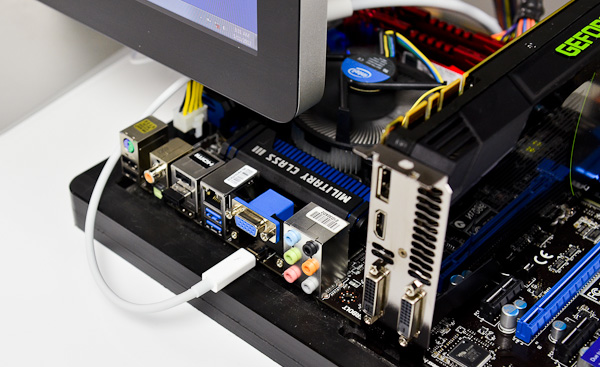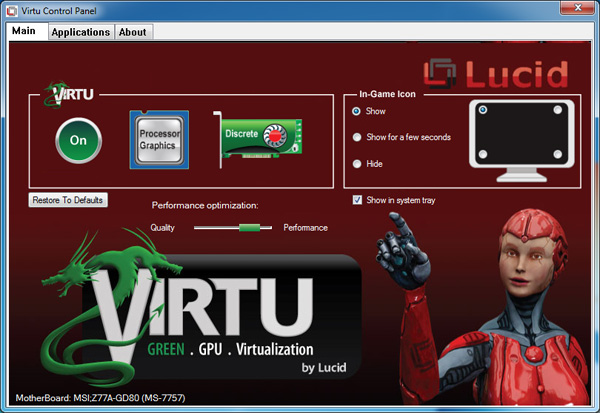A First Look at Thunderbolt on Windows with MSI's Z77A-GD80
by Anand Lal Shimpi on May 11, 2012 1:32 PM EST- Posted in
- Motherboards
- CPUs
- Intel
- MSI
- Thunderbolt
The Thunderbolt Display
The first test was hooking up Apple's Thunderbolt Display, the only Thunderbolt display device available on the market today. Although I shouldn't have been, I was a bit surprised when the display just worked. Intel's HD 4000 drove the 2560 x 1440 panel just fine and there weren't any funny issues displaying the lower res UEFI setup mode.
Despite Ivy Bridge being able to drive three independent displays, I was only able to simultaneously output to two connected displays on the GD80. All combinations of two worked however (TB + HDMI, TB + VGA, VGA + HDMI).
Once in Windows, the Thunderbolt Display's integrated GigE, Firewire and other controllers started popping up. Unfortunately Apple doesn't offer a direct download package for Thunderbolt Display drivers. You can either hunt down the controllers/drivers on their own, or you can build a Windows Support (driver) package using a Mac and the Boot Camp Assistant. I'd much rather Apple just offer an easy route for non-Mac Windows users to take advantage of the Thunderbolt Display as it's the only TB display on the market, but I can understand the lack of motivation there.
With the Boot Camp drivers installed, I got working GigE and Firewire 800. The Thunderbolt Display's integrated USB hub gave me issues however. Anything I plugged into it would either partially work (e.g. my mouse was detected but moving the cursor was far from smooth) or not work at all (e.g. my attached USB keyboard never worked). The other issue with the Thunderbolt Display is you get no brightness control, which can be a problem given how bright the panel gets. I've seen reports of people getting brightness control working via software tools but the solutions don't seem permanent.
Apple's Thunderbolt Display definitely works, but Windows users will likely want to wait for a Thunderbolt display that is built specifically with Windows in mind.
Virtu and Thunderbolt: It Works
From a software perspective, Thunderbolt is treated just like another display output driven by Intel's processor graphics. I installed a GeForce GTX 680 along with Lucid's Virtu GPU virtualization software to see if I could use the 680 for gaming but drive the display using Intel's processor graphics and the Thunderbolt port. The setup worked flawlessly.
Virtu recognized the configuration immediately once I had NVIDIA's drivers installed, and I was able to run the 680 headless - using only the Thunderbolt port to drive the external display. Intel's HD 4000 powered things in Windows, while the 680 kicked in for games.













98 Comments
View All Comments
sphigel - Friday, May 11, 2012 - link
"does anyone else find this whole "Military Grade" thing that has been showing up on motherboards lately to be one of the most embarassingly cheesy marketing gimmicks ever?"It's been around for at least 10 years that I know of but, yes, it is very cheesy.
A5 - Friday, May 11, 2012 - link
Military/defense grade is a real thing when dealing with component rating, though. It makes absolutely zero difference (besides the cost) on consumer-grade stuff, but it is a different set of specifications.jabber - Saturday, May 12, 2012 - link
Well if there were real 'military grade' they would cost $5000 each as you'd have £4900 worth of 'recertification costs' over the standard OEM issue the defence contractor buys in and then stamps 'military grade'.StormyParis - Friday, May 11, 2012 - link
It's nice to see CPU usage... 20% seems high, but I guess for high throughput it's bearable, but what CPU was in your setup ?Did you run into any compatibility problems. I'm still having those with USB, both 2 and 3.. which is very disappointing .
Death666Angel - Monday, May 14, 2012 - link
He said it in the Youtube video: Core i7 3770K. :-)Stanly.ok - Friday, May 11, 2012 - link
"pushing the Thunderbolt Display at its native 2560 x 1600 resolution""drive the Thunderbolt Display at 2560 x 1600"
looks like you miss 30" Cinema Display a lot ((=
coder543 - Friday, May 11, 2012 - link
This review was really unfair in my opinion. This is one of the first reviews of a non-Apple usage of Thunderbolt, and we don't even try Linux on it? You spent pages reiterating over and over and over about how Windows doesn't support hot plugging of those devices.And you didn't see what Ubuntu (or Fedora, or whatever else) did when hotplugging? Come on.
Sincerely,
slightly frustrated at the complete absence of Linux on Anandtech.
Metaluna - Friday, May 11, 2012 - link
Yeah, this is one of the problems with Thunderbolt that doesn't get a lot of coverage, though kudos to Anand for touching on it in this article.The problem I'm referring to is that TB just pushes the driver availability problem out to the external device, which is particularly problematic for storage devices. Want to take that nice TB external drive and move it between OSX, Windows, Linux, FreeBSD, etc? Well, now you not only have to make sure all those machines have a TB port and a compatible filesystem, you also have to make sure they all have a driver for whatever controller chip the enclosure has in it. With USB, eSATA, SAS etc, each of those machines can just have whatever controller works best for that OS.
Zoomer - Friday, May 11, 2012 - link
It's a PCIE bridge chip on the phy layer, so it should be transparent to the OS as mentioned.The driver issue would be the same as if the external device was plugged into an internal PCIE slot.
Klimax - Saturday, May 12, 2012 - link
One thing: Windows support hotplugging(it doesn't care what type of device it is in general), but drivers have to support it too and if they don't provide proper callbacks to I/O manager then hotplug cannot work as IOM has no way to inform driver about changes.